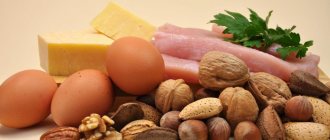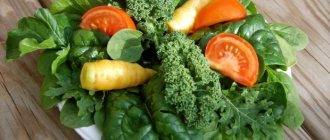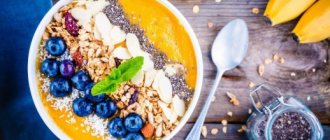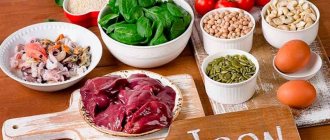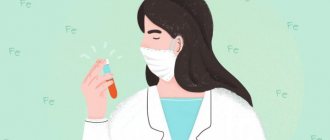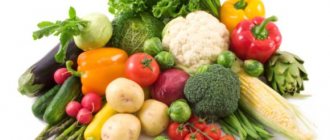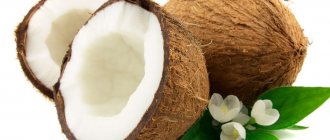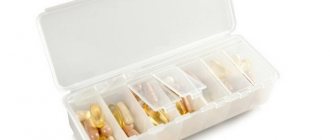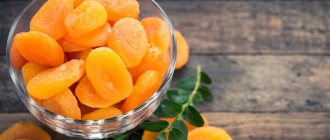Iron in the human body is responsible for the production of red blood cells. It is these red cells that carry oxygen throughout all tissues and organs, are responsible for oxidation and help systems “breathe” in the literal sense of the word.
Since iron is a component of hemoglobin and is directly involved in all body processes, it is important to monitor its levels and ensure sufficient iron intake from food. This must be done throughout life, since indicators change at different age periods. Let's find out what the daily requirement of iron is for each person.
Iron – what is it and why is it important?
Iron is a nutrient that plays a vital role in oxygen transport. It binds to hemoglobin, a special protein, and helps transport red blood cells from the lungs to other tissues in your body ().
Iron is naturally found in the foods you eat, and there are two main types - heme and non-heme iron.
The term "heme" comes from a Greek word that loosely translates to "blood." This type of iron is found in animal protein such as poultry, fish and beef.
Non-heme iron, on the other hand, comes from plant sources including legumes, green leafy vegetables, and nuts.
Heme iron is the easiest for the body to absorb and is 14–18% bioavailable in mixed diets. Non-heme iron, the source of iron in a vegetarian diet, has a bioavailability of 5–12% ().
Summary:
Iron is an essential nutrient. There are two types of iron in the human diet: heme iron comes from animal protein, and non-heme iron comes from plants. Your body can absorb heme iron more easily.
Why is iron needed in the body?
Iron is a component of hemoglobin. And accordingly, it participates in hematopoiesis and oxygen transfer to tissues. Iron helps normal biological oxidation. But most importantly, iron helps normalize the muscle and nervous system. If a person constantly has a feeling of weakness and fatigue, then there is a lack of iron.
Gender and age affect your needs
Iron requirements vary depending on gender and age.
Infants and children (up to 13 years)
The iron requirements of boys and girls are the same from infancy to late childhood. This is due to the fact that menstruation usually begins no earlier than 13 years of age ().
Newborn babies require minimal amounts of iron from their diet. They are born with a supply of iron absorbed through their mother's blood in the womb.
The adequate intake (AI) for children from birth to the first 6 months is 0.27 mg per day. AP is simply an average of what healthy breastfed babies typically consume. Thus, their needs are met only through breastfeeding or consuming baby food ().
Babies who spend less time in the womb, such as premature babies, need more iron than full-term babies. The same applies to low birth weight babies.
However, APs for preterm and low birth weight infants have not been established. In these cases, it is best to talk to your doctor about your child's iron needs ().
In the second 6 months of life, children aged 7 to 12 months should receive significantly more iron - 11 mg per day - according to the Recommended Daily Intake (RDI) ().
This is due to their needs related to the rapidly developing brain and its blood supply. Iron is critical for proper brain development.
As children get older (1 to 3 years), their iron requirements are 7 mg per day. Then, between the ages of 4 and 8, boys and girls should get 10 mg of iron from their diet daily.
In later childhood - from 9 to 13 years - children need to receive 8 mg of iron () daily from food.
Teenagers (14–18 years old)
For boys aged 14 to 18 years, the RDA for iron is 11 mg. It helps support growth spurts that are common at this age ().
Teenage girls need more iron than boys their age - 15 mg per day. This is due to the fact that they need not only to maintain growth, but also to compensate for the loss of iron during menstruation (, ,).
Adult men
Significant body and brain growth slows down by age 19. Thus, a man's iron needs stabilize in adulthood.
Whether 19 or 99 years old, young and older adult men need 8 mg of iron per day from food to maintain their health.
Highly active men, such as endurance athletes, may need more than this amount as their body loses iron through sweat ().
Adult women
A typical adult—male or female—stores between 1 and 3 grams of iron in their body. At the same time, they lose about 1 mg every day from the surface of the skin and mucous membranes, such as the intestinal mucosa ().
Women who menstruate need more iron. This is because blood contains about 70% of your body's iron. At the beginning of the menstrual cycle, the body loses about 2 mg per day (, , ,).
Between the ages of 19 and 50, women need 18 mg of iron per day. In female athletes, the need for iron increases, since some of the iron is lost through sweating.
Older women aged 51 years and older need 8 mg of iron per day. This is explained by the onset of menopause ().
Iron requirements during pregnancy and lactation
During pregnancy, your iron requirements increase to 27 mg as you also need to meet the needs of the fetus ().
If you are primarily breastfeeding, your iron requirements should decrease. Under these conditions, women need 9–10 mg of iron depending on their age. These levels take into account both the woman’s own needs and the child’s ().
During lactation, the hormone prolactin is produced, which can suppress menstruation. Thus, these lower recommendations assume that iron is not lost during menstruation (, ).
Iron Requirements Overview
Here's a visual summary of how much iron a person needs per day depending on gender and age (, ,):
| Age group | Male (mg/day) | Female (mg/day) |
| From birth to 6 months | 0,27 | 0,27 |
| 7–12 months | 11 | 11 |
| 1–3 years | 7 | 7 |
| 4–8 years | 10 | 10 |
| 9–13 years | 8 | 8 |
| 14–18 years old | 11 | 15 |
| 19–30 years old | 8 | 18 |
| 31–50 years | 8 | 18 |
| 51+ years | 8 | 8 |
| Pregnancy | — | 27 |
| Lactation (under 18 years old) | — | 10 |
| Lactation (19–50 years) | — | 9 |
Summary:
Iron requirements depend on age and gender. Infants, children and adolescents have a wide range of iron needs. Adult men's needs are more stable, while women have different needs depending on age and whether they are pregnant or not.
How much iron is required per day for men
On average, the daily iron requirement for men is up to 10 mg. But this indicator is quite conditional, since if there are problems with blood supply, with a low hemoglobin level, or anemia of various stages, the need for the daily requirement of iron for men may increase. Among the basic factors that increase the daily iron intake for a healthy man over the age of 30, it is worth highlighting the following:
- active physical activity;
- extended working hours;
- taking certain medications, such as sexual stimulants.
Getting the right amount
Interestingly, the way your body absorbs iron is unique in that it does not excrete the mineral, but instead processes and retains it ().
So getting too much or too little iron can be a problem.
Excessive iron intake
Iron is concentrated in human blood. Because of this, people who regularly receive blood transfusions, such as those undergoing cancer treatment, may be at risk of receiving too much iron ().
This condition is known as iron overload. This occurs because your body cannot get rid of iron stores before receiving more from a blood transfusion.
Although iron is essential, excess iron can be toxic and can damage your liver, heart and other vital organs.
However, iron overload is not a problem when your iron comes only from food—unless you have a condition like hemochromatosis, which causes increased iron absorption in the digestive tract.
Keep in mind that the Tolerable Upper Intake (TUL)—the highest amount you can safely consume—is 40–45 mg per day depending on your gender and age ().
Iron deficiency
Pregnant women, infants, athletes, and teenage girls are most at risk for iron deficiency (, , , ).
Children who do not get enough iron may gain weight slowly. They may also appear pale, tired, lack appetite, get sick more often, and be irritable.
Iron deficiency can also lead to poor concentration and a negative impact on children's academic performance ().
Not getting enough iron can also lead to iron deficiency anemia, the most common nutrient deficiency condition in the world (, ,).
If you have this condition, your body does not have enough iron to make new red blood cells. This is usually caused by either a deficiency of iron in the diet or chronic blood loss ().
Symptoms of iron deficiency and excess
If you don't get enough iron, you may feel weak and tired, and your body may bruise easily. You may be pale, feel restless, or have cold hands and feet or brittle nails. You may also experience abnormal urges, such as the urge to eat soil, a condition known as pica ().
On the other hand, if you experience joint pain or changes in skin tone, or if you get sick easily, you may be getting too much iron. If you regularly receive blood transfusions you may be especially at risk ().
If you are concerned that you are getting too much or too little iron, be sure to talk to your doctor.
Summary:
Getting too much iron can be a problem for people who receive regular blood transfusions and can lead to toxicity. Low iron intake can lead to iron deficiency anemia.
Symptoms of iron excess and deficiency
To accurately determine the level of the element, a biochemical blood test is prescribed. Excess iron in the body is observed less often than deficiency, but also negatively affects health. This condition is called hemochromatosis. This is indicated by pain in the right hypochondrium and redness of the skin.
Low iron levels are more common than high iron levels. The microelement retains oxygen in red blood cells, so when it is deficient, the body begins to experience hypoxia (oxygen deficiency). In the most severe cases, iron deficiency anemia (popularly known as anemia) may develop. It is especially common in infants and pregnant women.
Symptoms of iron deficiency in the body:
- fatigue and muscle weakness;
- dry hair and brittle nails;
- pale skin (also indicates a lack of hemoglobin);
- tinnitus, headache and dizziness;
- rapid heartbeat and shortness of breath;
- bluish tint to lips and nails.
Even with a deficiency, you may notice difficulties and discomfort when swallowing. Others note that their taste preferences changed in strange ways, for example, they wanted to chew paper or chalk.
In some cases, with iron deficiency, a person feels a loss of strength. Even after sleep he feels tired, and the slightest exertion causes severe shortness of breath. Another person may experience constant colds, which is caused by a decrease in immunity.
On this topic:
How to strengthen the immune system in spring and why it is really necessary (the simplest methods and tips)
Other circumstances that affect iron requirements
Other circumstances, such as dietary restrictions, medications and medical conditions, may affect your iron needs.
Dietary restrictions
While the modern diet typically contains 7 mg of iron per 1,000 calories, your body will only absorb 1–2 mg of iron ().
People who follow a vegan diet need 1.8 times the daily value compared to those who eat meat. This is because non-heme iron is not as readily available to your body as heme iron (,).
For example, a healthy adult woman between the ages of 19 and 50 who regularly eats animal protein may need 18 mg of iron per day. If she follows a vegan diet, she will need about 32 mg.
Some medications
Some medications can deplete stores or interact with iron. They may change your iron needs.
For example, iron supplements affect the effectiveness of levodopa, a standard drug for treating Parkinson's disease, as well as levothyroxine, used to treat thyroid cancer and goiter (,).
Proton pump inhibitors, such as those used to treat acid reflux, negatively affect iron absorption. Taking them consistently over several years can increase your iron requirements ().
If you are taking any of these medications, talk with your doctor to determine your optimal iron needs.
Current diseases
Certain medical conditions can affect your iron needs.
For example, if you have gastrointestinal bleeding due to ulcers or cancer, the additional blood loss may lead to an increased need for iron. Regular kidney dialysis also increases your iron requirements ().
What's more, a lack of vitamin A can affect your ability to effectively absorb iron. This may increase your iron requirements ().
If you feel that you are not getting enough iron from your diet, you should consult your doctor.
Summary:
Medicines, certain medical conditions, and any dietary restrictions can affect how much iron you need to get each day. For example, vegans and vegetarians should get 1.8 times more iron daily.
Preparations with iron
You can replenish iron reserves in the body with the help of medications. Depending on the extent of the deficiency, you can choose tablets, vitamin complexes and various dietary supplements (BAS).
Such drugs are widely represented in modern pharmacology. They vary in the amount of microelement they contain, and can also be domestic or imported.
Under no circumstances should you prescribe such drugs yourself, and you should start taking them only after consulting a doctor.
How to get enough iron from food
Heme iron is the most efficiently absorbed type of iron. It is mainly concentrated in shellfish, offal, poultry and eggs.
Rich vegetarian sources of iron include chickpeas, quinoa, seeds, beans, fortified grains and green leafy vegetables.
In addition, dark chocolate contains a surprising amount of iron - 19% of the Daily Value per 30-gram serving ().
Moreover, what you eat along with iron-rich foods is also important. Combining your high-iron foods with foods rich in vitamin C, such as fruits and vegetables, increases the rate of iron absorption ().
For example, drinking orange juice with a bowl of eggs improves the body's absorption of iron from eggs.
Conversely, eating iron-rich foods with foods high in calcium, such as drinking milk with a plate of eggs, interferes with iron absorption. Therefore, it is better to consume calcium-rich foods at separate times ().
Supplements
If you think you need to supplement your diet, commercial iron supplements contain iron in the form of ferrous fumarate, ferrous sulfate, and ferrous gluconate.
They contain varying amounts of elemental iron. Elemental iron refers to the amount of iron in a supplement that your body can absorb. Ferrous fumarate gives the most - 33%, and iron gluconate the least - 12% ().
Iron supplements can cause constipation and intestinal discomfort, so it is best to get iron from food as much as possible ().
It is generally not recommended that children or infants take iron supplements—they should instead get iron from their diet. If your baby was born premature or low birth weight, talk to your doctor about their iron needs.
Multivitamins typically contain 18 mg of iron, or 100% of the RDI. Supplements containing only iron may contain about 360% of the RDI. Getting more than 45 mg of iron per day is associated with intestinal disorders and constipation in adults ().
Summary:
Regular consumption of iron-rich foods helps maintain iron levels in the body, and combining them with vitamin C-rich foods improves iron absorption. If you feel you are getting too much or too little iron, consult your doctor.
What determines the daily iron requirement for women?
Representatives of the fair half of humanity need a larger amount of the mineral than men. Therefore, it is important to know the daily iron requirement for women in mg.
The fact is that women have a more active metabolism, regular menstruation, and it is necessary to replenish the body with useful microelements for an established blood metabolism process. For a girl, starting from puberty, the daily intake of iron is 18 mg. After menstruation or surgery, the dose is increased to 20 mg.
Girls who often “go on a diet”, along with the extra pounds and centimeters in volume, literally “wash” the mineral out of the blood. Therefore, if you are planning long fasting days, you should leave foods rich in Fe in your diet and first consult with a nutritionist, a specialist in healthy nutrition.
Why does the body's need for iron increase during pregnancy?
For those ladies who are planning to become a mother, the daily iron intake can be increased to 25 mg. During pregnancy, in particular in the first trimester, when the fetus is developing organs, especially an independent circulatory system, as well as during lactation, the rate of iron consumption per day increases almost 2 times.
It is especially important to ensure adequate iron intake during pregnancy. A low level provokes the development of anemia, which is critical for the expectant mother and child. The daily iron requirement for anemia in pregnant women usually increases. Lack of oxygen in tissues can cause irreversible consequences: improper development of the nervous and circulatory system in the baby, oxygen starvation, edema, shortness of breath in the mother. To prevent this from happening, the woman is prescribed special medications containing iron.
Even in the absence of diagnosed anemia during pregnancy, gynecologists recommend revising the daily iron intake for women by adding foods that contain it in the proper quantities to the diet: boiled beef and liver, apples, walnuts. Vitamin complexes with this mineral are often additionally prescribed.
It is extremely important for pregnant women to remember that iron is absorbed more quickly and fully by the body along with vitamin C, which is abundant in seasonal fruits and vegetables, as well as in fortified complexes in the form of tablets and syrups.
After the baby is born, the daily iron intake continues to be 40–50 mg, since blood loss during childbirth can cause rapidly developing anemia. This is why it is so important to follow the daily iron requirement for women with anemia.
Summarize
- Iron requirements are most stable in men. Women's needs change depending on their age and whether they are pregnant or not.
- Your ideal iron intake is also affected by other factors, such as dietary restrictions, ongoing health problems, and certain medications you take.
- Heme iron is most easily absorbed by the body and comes from animal protein. Combining iron with vitamin C helps the body absorb it better.
- Keep in mind that if you rely solely on non-heme (plant) iron, you will need to consume more iron overall.
- Getting too much iron can lead to iron overload, while not getting enough iron can lead to iron deficiency anemia.
- If you have any doubts about how much iron you are getting, talk to your doctor.
Tags: Iron
- Related Posts
- Magnesium Supplements: Benefits, Side Effects and Dosage
- Whey protein isolate or concentrate: which is better?
- Steroids: harm and benefit, application, side effects
« Previous entry
Useful properties of iron
The microelement iron is vital in the human body and plays a big role in accelerating oxygen exchange processes. Participates in its delivery from the lungs to all tissues and organs through the circulatory system. The main storage of iron is ferritin, a globular protein complex. The trace element is contained in enzymes in the form of heme, which is present in large quantities in the hemoglobin of the blood and colors it red. Other complexes other than heme occur in an important enzyme involved in DNA synthesis. Small amounts of iron are also found in the bone marrow, liver, muscles and spleen. It enters the body with food and is excreted through sweating and the urinary system.
Beneficial properties of iron in the human body:
- prevents the development of anemia;
- removes carbon dioxide from the body;
- supports the functioning of the thyroid gland;
- increases immunity and resistance to bacteria;
- fights toxins in the liver;
- enhances the effect of B vitamins.
Hemoglobin, consisting mostly of iron, binds with oxygen and delivers it to all organs and tissues. Giving oxygen and combining with carbon dioxide, hemoglobin transports it to the lungs, from which it is exhaled by the person.
Table of foods containing iron
Products of plant or animal origin can raise hemoglobin.
Products of animal origin (mg/100 g.)
| By-products | |
| pork liver | 23.6 |
| chicken liver | 19.7 |
| beef liver | 16.7 |
| beef heart | 9.1 |
| pork heart | 8.5 |
| Meat | |
| beef | 6.7 |
| mutton | 5.8 |
| pork | 4.8 |
| chicken | 3.7 |
| turkey | 2.7 |
| Fish (canned) | |
| sardines | 3.5 |
| tuna | 2.6 |
| Other seafood | |
| crabs | 9.5 |
| mussels | 7.1 |
| black caviar | 4.5 |
| Eggs (yolk) | |
| chicken | 7.1 |
| quail | 6.1 |
Products of plant origin (mg/100 g.)
| Cereals | |
| buckwheat | 7.7 |
| oatmeal | 4.8 |
| wheat | 3.9 |
| Grain, beans | |
| lentils | 12,1 |
| wheat bran) | 10,5 |
| chickpeas | 7.6 |
| Rye bread | 4,2 |
| peas | 2,6 |
| Vegetables, greens | |
| spinach | 4.1 |
| beet | 3.9 |
| White cabbage | 2.2 |
| Nuts | |
| peanut | 4.9 |
| almond | 3.9 |
| walnut | 3.1 |
| Fruits, citruses | |
| dried apricots | 12 |
| prunes | 11 |
| pomegranate | 6 |
| persimmon | 2,8 |
| fresh/dried pear | 2,8/13 |
| fresh/dried apple | 2,7/15 |
| peach | 4.8 |
| apricot | 2.9 |
| raisin | 3 |
| Berries | |
| dogwood | 4.5 |
| black currant | 2.4 |
| blueberry | 8.1 |
| rose hip | 11.3 |
| Other | |
| porcini mushrooms | 34 |
| halva | 33.2 |
| seaweed | 17 |
| pumpkin seeds | 14 |
Vitamin-mineral complexes containing iron
The best complex sources of iron are AlfaVit, Vitrum, Doppelherz, Complivit Iron, Multi-Tabs, Supradin, Centrum. The average daily preventive dosage for adults is 13-19 mg of ferrum.
Russian-made drugs Composition for ferrum content and other components (mg):
| A drug | Iron | Calcium | Copper | Vitamin C |
| Complivit | 15 | — | + | + |
| AlfaVit for men | 15 | + | + | + |
| AlfaVit Classic | 14 | + | + | + |
Calcium. Inhibits the absorption of iron by the body.
Copper. During the “journey” of iron - from absorption to the synthesis of hemoglobin - a number of enzymes with copper in the structure are involved. This microelement is always added to iron by self-respecting manufacturers.
Vitamin C. Desirable for improving the absorption of iron by the gastrointestinal tract, required when consuming plant-based “iron” foods.
A cost-effective solution is Hematogen. Its range will satisfy different tastes, suitable for adults and children.
Foreign complexes Drugs with daily “adult” dosage:
- Multi-tabs;
- Vitrum;
- Centrum.
Lower dosage (11-12.5 mg):
- Doppelhertz;
- Supradin.
Duovit has extremely high levels - 30.310 mg.
Caution is required with the drug. There is a high probability of gastrointestinal upset (diarrhea, constipation, nausea, vomiting, etc.).
Description and characteristics
Iron (Fe) is one of the trace elements that is extremely important for humans. This is due to the fact that it is involved in numerous chemical processes that occur in the body. It may not contain much of it - only 4-5 g for an adult, but this in no way diminishes its importance. Fe is one of the components of hemoglobin, and is also included in the structure of myoglobin and cytochromes.


